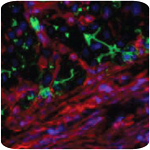Laboratory of Virology and Infectious Disease

HCV causes liver disease such as fibrosis and cirrhosis. Fibrotic areas in an infected liver are shown in red.
A new HCV reporter system shows the virus infecting living cells (appearance of magenta nuclei).
Pathogenesis
Infection with a virus of the family Flaviviridae can cause a wide variety of pathologies, including hemorrhagic fever (dengue virus and yellow fever virus), encephalitis (West Nile virus), hepatocellular carcinoma and immune cell abnormalities (HCV). Understanding how these viruses cause disease, as well as efforts to develop vaccines and antiviral therapies, will require models of infection that mimic the complexity of the human liver or other target organs. In close collaboration with the laboratory of Dr. Sangeeta Bhatia at Massachusetts Institute of Technology, we have recently shown that HCV can infect otherwise healthy human hepatocytes in culture. Unlike previous culture systems, which depend on cancerous cells, studying HCV infection of normal liver cells may yield clues about how the virus causes disease. These studies have been facilitated by our recent development of a novel HCV reporter system. This reporter, which depends on relocalization of a fluorescent substrate after cleavage by the viral protease, allows us to watch in real time as HCV spreads through a culture. Use of these new tools may reveal previously unknown mechanisms by which HCV causes disease.
The development of antiviral drugs and vaccines targeting HCV has been severely hampered by the lack of robust small animal model systems. HCV is primarily a pathogen of humans and does not infect mice. Research Assistant Professor Alexander Ploss is currently developing and optimizing new models of infection by engrafting mice with specific permissive cell types. Our recent discovery that only two human molecules - the HCV co-receptors occludin and CD81- are required for viral uptake by mouse cells is a key advance. Robust mouse models will be invaluable in developing an HCV vaccine, as well as for preclinical safety and efficacy testing of antiviral drugs. The urgent need for preventative and therapeutic strategies for HCV and other Flaviviridae family members makes the development of these in vivo systems vitally important.
Further reading
- Ploss A, Khetani SR, Jones CT, Syder AJ, Trehan K, Gaysinskaya VA, Mu K, Ritola K, Rice CM, Bhatia SN. Persistent hepatitis C virus infection in microscale primary human hepatocyte cultures. Proc Natl Acad Sci U S A. 2010 Feb 16;107(7):3141-5
- Jones CT, Catanese MT, Law LM, Khetani SR, Syder AJ, Ploss A, Oh TS, Schoggins JW, MacDonald MR, Bhatia SN, Rice CM. Real-time imaging of hepatitis C virus infection using a fluorescent cell-based reporter system. Nat Biotechnol. 2010 Feb;28(2):167-71.
- Ploss A, Rice CM. Towards a small animal model for hepatitis C. EMBO Rep. 2009 Nov;10(11):1220-7.
- Legrand N et al. Humanized mice for modeling human infectious disease: challenges, progress, and outlook. Cell Host Microbe. 2009 Jul 23;6(1):5-9.
